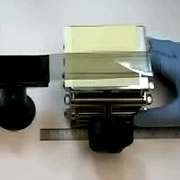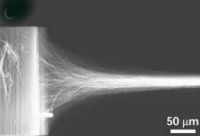Science Fiction
Dictionary
A B C D E F G H I J K L M N O P Q R S T U V W X Y Z
Carbon Nanotube Ribbon For Space Elevator

Carbon nanotube ribbons created in a University of Texas laboratory may stretch all the way into space. According to research to be published in Science today, Dr. Mei Zhang and his team have succeeded in creating yard-long ribbons of carbon nanotubes - just the sort of ultra-light, ultra-strong filaments needed to create the space elevator (among many other things).

(From Carbon Nanotube Ribbon)
The researchers started with a "forest" of nanotubes about 300 micrometres long, held together by van der Waals forces. They used the glue from a post-it note to tug at right angles at the nanotubes on the outside of the forest (see graphic below).
Still held together by van der Waals forces, the nanotubes were spun out into a metre-long strip no more than 10 micrometers thick. "When you pull on one, it actually pulls the others but it has to rotate," says researcher Ken Atkinson. Using this method the researchers produced the nanotube ribbon at a rate of 7 metres per minute, about three times slower than the rate for commercial wool spinning at 20 metres per minute.

(From Carbon Nanotube Ribbon Spun from Vertical Forest of Nanotubes)
The researchers then laid the nanotube ribbon on a piece of glass and soaked it in ethanol. This caused the nanotubes to line up more closely with each other making a transparent ribbon just 50 nanometres thick. Sheets more than a meter long, about two inches wide, and less than one-thousandth the width of a human hair thick can be pulled in less than a minute, by hand in the lab.
In his 1978 novel The Fountains of Paradise, Arthur C. Clarke writes about the enabling technology for a space elevator - the one-dimensional diamond (carbon) crystal:
"So you do have an invisible wire. Clever - but what use is it, except for parlour tricks?""I can't blame you for jumping to that conclusion. But it's quite wrong. The reason you can't see this sample is that it's only a few microns thick. Much thinner than a spider's web."
"...What is it?"
"The result of two hundred years of solid-state physics. For whatever good that does, it is a continuous pseudo-one dimensional diamond crystal - though it's not actually pure carbon. There are several trace elements in carefully controlled amounts. It can be mass-produced only in the orbiting factories, where there's no gravity to interfere with the growth process."
"Fascinating ... I can appreciate that this may have all sorts of technical applications. It would make a splendid cheese cutter."
(Read more about the One-dimensional Diamond Crystal)
A space elevator is essentially a long cable that is anchored on Earth at one end - and "anchored" at the other end 35,000 kilometers away by a satellite in geosynchronous orbit. Gravity and centripetal acceleration keeps the cable taut; a small elevator, or car, can crawl up the elevator at a fraction of the energy expenditure needed to actually hurl an object into orbit. Putting a satellite in orbit could cost hundreds of dollars per pound, rather than $7,000 per pound as it does on the space shuttle.
Read more at Little creation, big step and Space elevator comes closer to reality.
Scroll down for more stories in the same category. (Story submitted 8/19/2005)
Follow this kind of news @Technovelgy.| Email | RSS | Blog It | Stumble | del.icio.us | Digg | Reddit |
Would
you like to contribute a story tip?
It's easy:
Get the URL of the story, and the related sf author, and add
it here.
Comment/Join discussion ( 31 )
Related News Stories - (" Space Tech ")
Will Space Stations Have Large Interior Spaces Again?
'They filed clumsily into the battleroom, like children in a swimming pool for the first time, clinging to the handholds along the side.' - Orson Scott Card, 1985.
Reflect Orbital Offers 'Sunlight on Demand' And Light Pollution
'I don't have to tell you about the seven two-mile-diameter orbital mirrors...'
Chrysalis Generation Ship to Alpha Centauri
'This was their world, their planet —
this swift-traveling, yet seemingly moveless vessel.' - Nat Schachner, 1934
The First Space Warship For Space Force
'Each of the electrical ships carried about twenty men...' - Garrett P. Serviss, 1898.
Technovelgy (that's tech-novel-gee!) is devoted to the creative science inventions and ideas of sf authors. Look for the Invention Category that interests you, the Glossary, the Invention Timeline, or see what's New.
Science Fiction
Timeline
1600-1899
1900-1939
1940's 1950's
1960's 1970's
1980's 1990's
2000's 2010's
Current News
Bone-Building Drug Evenity Approved
'Compounds devised by the biochemists for the rapid building of bone...'
Secret Kill Switch Found In Yutong Buses
'The car faltered as the external command came to brake...'
Inmotion Electric Unicycle In Combat
'It is about the size and shape of a kitchen stool, gyro-stabilized...'
Grok Scores Best In Psychological Tests
'Try to find out how he ticks...'
PaXini Supersensitive Robot Fingers
'My fingers are not that sensitive...'
Congress Considers Automatic Emergency Braking, One Hundred Years Too Late
'The greatest problem of all was the elimination of the human element of braking together with its inevitable time lag.'
The Desert Ship Sailed In Imagination
'Across the ancient sea floor a dozen tall, blue-sailed Martian sand ships floated, like blue smoke.'
The Zapata Air Scooter Would Be Great In A Science Fiction Story
'Betty's slapdash style.'
Thermostabilized Wet Meat Product (NASA Prototype)
There are no orbiting Michelin stars. Yet.
Could Crystal Batteries Generate Power For Centuries?
'Power could be compressed thus into an inch-square cube of what looked like blue-white ice'
India Ponders Always-On Smartphone Location Tracking
'It is necessary... for your own protection.'
Amazon Will Send You Heinlein's Knockdown Cabin
'It's so light that you can set it up in five minutes by yourself...'
Is It Time To Forbid Human Driving?
'Heavy penalties... were to be applied to any one found driving manually-controlled machines.'
Replace The Smartphone With A Connected Edge Node For AI Inference
'Buy a Little Dingbat... electropen, wrist watch, pocketphone, pocket radio, billfold ... all in one.'
Artificial Skin For Robots Is Coming Right Along
'... an elastic, tinted material that had all the feel and appearance of human flesh and epidermis.'
Robot Guard Dog On Duty
I might also be thinking of K-9 from Doctor Who.
